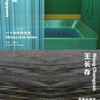分享到微信,
请点击右上角。
再选择[发送朋友]
或[分享到朋友圈]


「Wang Changcun: The Sensation of Logic」
Curator: Lu Leiping
Exhibition Duration: From September 21st to December 2nd, 2018
Opening Reception: Friday, September 21st, 5pm
Venue: OCAT Shanghai, 30 Wen’an Road, Jing’an District, Shanghai
Curatorial Statement
Lu Leiping
In discussing the formal categorization of Wang Changcun’s art practice, he especially mentioned the notion of “Electronic Brain Art”. At first, the term “Electronic Brain” immediately reminds one of the images of an electronic chip implanted in the human brains of Japanese manga artist Shirow Masamune’s Ghost in the Shell. Wang Changcun’s “Electronic Brain Art” does not necessarily manifest in robotic forms. He uses programming software such as Python, Max and others to set the logic and pattern for generating his works, and processes the sound, image and other materials he collects, categorizes, collages and transforms through formulas and algorithms in order to construct an audio-visual space that integrates natural life with digital technology. “Electronic Brain Art” is neither AI art nor programing art per se. It emphasizes on the limited proactivity and agency of an engineering artist’s writing of artistic programming, which directly impact their increased probability for improvised and random outcomes, which often offer pleasant surprises for the viewers.

Dune, Computer Program Generated Image, 2018
Courtesy the artist
The Sensation of Logic marks Wang Changcun’s first solo exhibition at an art museum, presenting more than a dozen works spanning from experimental music, sound installation, interactive video installation, and digital images Wang Changcun has produced since 2009. As one of the Chinese pioneers in experimental music and digital compositions created with computer programing, his installations and video works were once the games for the artist's own entertainment, saved on his computer’s hard-drive and rarely shown to others. For this exhibition, the artist chose to publish five different albums of electronic music, and like the index of the exhibition, scattered at different corners alluding to his other installations and videos. These works with seemingly disparate forms of representation are threaded together by an intriguing internal logic, and at the same time reveal his geeky sense of humor and lyricism.

Viewport Duet, Intreractive Video Installation, 2017
Courtesy the artist
Flicker (2009) is somewhat a conventional sound artwork, its audio files are collected from everyday sounds ranging from the cicada chirping, rehearsal room, the public bus, to noises heard in restaurants… these often overlooked ambient sounds can easily bring the listener back to the time and place they were heard previously. A similar logic applies in the audio installation Massage Chair (2012), where it assumes that when one hears an amplified sound of a massage chair, one would feel the physical vibration even sitting on a regular beach chair, so one's virtual experience of being massaged would seem real.

Flicker, Computer Music, 2018
Courtesy the artist
Other collected data were "craftily" put through various types of tools programmed with Max in an attempt to generate a series of seemingly bizarre things. For instance, the electronic improvisation of piano concerto in the name of “live performance” from the album The Klone Concerts (2009), the five-character-quatrain that are nothing like its conventional forms nevertheless follows its ping/ze pattern found in Five-character-quatrain (2009); and the symmetrical digital image conveying the aesthetics of abstraction in the Turner Test (2010), were actually pixels drawn from the details of digital images found online of the British master, J.M.W. Turner’s landscape paintings.

Turner Test: Fisherman at Sea, Pixel Image, 2010
Courtesy the artist
In all seriousness, Wang Changcun probably has never replicated a classical music concert, a five-character-quatrain or a classical painting. Instead, he’s fascinated by the outcomes of the various types of games, to the point that his work has certain qualities of a “lame joke”. Quick Look (s02e08) (2018) compresses an episode of American TV series into one enormous image, so one could watch an entire episode at one glance; likewise, the audio-visual installation Aurum (2018) compresses 50 top hit songs into one “super gold” song. Both of these works are solutions for tl; dr (too long; didn’t read), an online abbreviation. These works wittily respond to the foolish phrase with its own folly, while adopting the method of collage from Pop Art to satirize the fast consumption of popular culture.

Quick Look (s02e08), Computer Program Generated Image, 2018
Courtesy the artist
The audio installation tucked at the back of the exhibition, A Semitone (Timer) (2014), may seem like a ghostly sound following the viewer throughout the exhibition, which is generated by extending a semitone to the duration of eight hours; like the album Iterator (2017) that simulated 100 digital songs at once with the same algorithm, their scales pose a difficult question for viewers of this exhibition: how would you fully experience these works of art?

Aurum, Computer Program Generated Video, 2018
Courtesy the artist
The title of the exhibition draws its inspiration from the French philosopher Gilles Deleuze’s book, Francis Bacon: The Logic of Sensation. Logic can be explained, while sensation may not be defined definitively. Three windows for C minor (2018) comprises of three moving windows moving within a framework. The angle and speed at which of the windows hit the frame are done at random, therefore the speed and rhythm at which Bach's Fugue in C Minor would also play in an improvised and disorderly fashion. In comparison to the other works that were grounded on his overall logical basis, the electronic song DO NOT MICROWAVE (2011) and digital image Dune (2018) follow his sense, and their outcomes meet the elegant rhythm and images that the artist is inherently drawn. The difference between the beautiful and the ugly for Wang Changcun in fact only depends on setting or adjusting on one or a few parameters, so is for reality and virtual reality. In the double channel video Viewport Duet (2017-2018), Wang distorts people’s everyday movement into frames and color blocks of two-dimensional games; the joystick in this installation gives its viewer the power to adjust the parameters and its visual effects. This summer, Wang Changcun released the vinyl record Song of Anon (2018) and simultaneously released the eponymous software on his personal website. So, who is the anonymous one? It must be no other than the simulation program he uses for music composition. And by using this program, anyone could program in order to carry on the song of the anonymous indefinitely, and without repetition…

Song of Anon, Computer Music, 2018
Courtesy the artist
About Artist
Wang Changcun
Sound Art
Electronic Music
Computer Music
Software&
Internet Art
Currently based in Hangzhou and Shanghai, China, Wang Changcun (AYRTBH) is a sound artist, electronic musician and computer bug programmer. As one of the Chinese pioneers in experimental music and computer-programmed digital composition, Wang Changcun has created vast digital and cross-media artworks under the name of “AYRTBH”. Wang Changcun got his solo CD The Mountain Swallowing Sadness published by the Belgian label Sub Rosa, and Parallel Universe by the American label Post-Concrete. He recently focuses on the Internet Art and Computer Music, and starts to make the iOS software and computer-programmed images. AYRTBH’s 2017 album MTK was released by American label Detroit Underground. In 2018, Song of Anon, the latest album is released by Beijing’s independent label D-Force.

来源:原创: Lu Leiping

分享到微信,
请点击右上角。
再选择[发送朋友]
或[分享到朋友圈]

